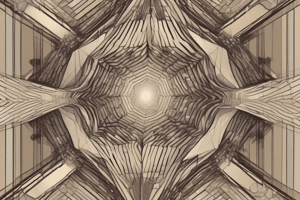Podcast
Questions and Answers
What is the angle of the reflected ray compared to the angle of the incident ray?
What is the angle of the reflected ray compared to the angle of the incident ray?
- Greater than the angle of the incident ray
- Perpendicular to the angle of the incident ray
- Less than the angle of the incident ray
- Equal to the angle of the incident ray (correct)
Why can we see illuminated surfaces from any position?
Why can we see illuminated surfaces from any position?
- Because of the law of refraction
- Because of the law of reflection
- Because of diffuse reflection (correct)
- Because of the angle of incidence
What happens to light when it encounters a boundary between two transparent media?
What happens to light when it encounters a boundary between two transparent media?
- A portion of it is reflected and a portion is transmitted (correct)
- It is absorbed by the surface
- It is completely transmitted into the second medium
- It is completely reflected back into the first medium
In what plane is the reflected ray always found?
In what plane is the reflected ray always found?
Why do mirrors produce clear images, but most natural surfaces do not?
Why do mirrors produce clear images, but most natural surfaces do not?
What is the relationship between the angle of incidence and the angle of refraction, according to Snell's law?
What is the relationship between the angle of incidence and the angle of refraction, according to Snell's law?
What is the index of refraction of a medium?
What is the index of refraction of a medium?
What happens to light during refraction?
What happens to light during refraction?
What is the key difference between reflection and refraction?
What is the key difference between reflection and refraction?
What is the relationship between the angle of incidence and the angle of reflection?
What is the relationship between the angle of incidence and the angle of reflection?
Flashcards are hidden until you start studying
Study Notes
Light Rays and Their Behaviors
- Light rays change direction when they reflect off a surface, move from one transparent medium into another, or travel through a medium whose composition is continuously changing.
Law of Reflection
- States that, on reflection from a smooth surface, the angle of the reflected ray is equal to the angle of the incident ray.
- Angles are measured with respect to the normal to the surface (a line perpendicular to the surface).
- The reflected ray is always in the plane defined by the incident ray and the normal to the surface.
Mirrors and Diffuse Reflection
- Plane and curved mirrors produce images that can be understood using the law of reflection.
- Most natural surfaces are rough on the scale of the wavelength of light, causing parallel incident light rays to be reflected in many different directions (diffuse reflection).
- Diffuse reflection allows us to see most illuminated surfaces from any position.
Refraction
- Occurs when light traveling in one transparent medium encounters a boundary with a second transparent medium (e.g., air and glass).
- A portion of the light is reflected, and a portion is transmitted into the second medium.
- As transmitted light moves into the second medium, it changes its direction of travel (refraction).
- Law of Refraction (Snell's Law): n1 sin θ1 = n2 sin θ2, where n1 and n2 are the indices of refraction of the first and second media, respectively.
Index of Refraction
- A dimensionless constant equal to the ratio of the speed of light in a vacuum to its speed in a medium.
Key Differences between Reflection and Refraction
- Reflection: Light rebounds after hitting a surface (e.g., mirrors).
- Refraction: Light shifts its path as it travels through a material, causing the light to bend (e.g., lenses).
Reflection vs. Refraction
- Reflection: Occurs on a plane, with the light entering the medium returning to the same medium.
- Refraction: Occurs when light passes through a surface, changing direction and medium.
Studying That Suits You
Use AI to generate personalized quizzes and flashcards to suit your learning preferences.



